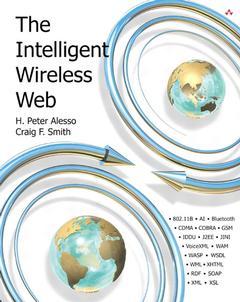The intelligent wireless Web
Auteurs : ALESSO Peter H., SMITH Craig F.

Building tomorrows Intelligent Wireless Web: the first complete guide for technical professionals.
- Integrating the key technologies of the next-generation Web: standards, challenges, integration, economics, and more.
- Wireless personal area networks, speech interfaces, nomadic software, AI, and next-generation Web architecture.
- People-to-device communication, device-to-device interaction, and device-to-people connections.
H. Peter Alesso is President of Video Software Laboratory, a leader in Internet-based video streaming technology. With 20 years of experience in computational engineering at Lawrence Livermore National Laboratory (LLNL), he has extensive background with a wide range of advanced platforms and applications. Craig F. Smith is an engineer with 30 years experience in advanced technology R&D. He is currently Deputy Associate Director of the Energy and Environment Directorate at LLNL.
List of Tables.
Introduction.
Acknowledgements.
About the Authors.
I. CONNECTING PEOPLE TO DEVICES.
1. Developing a Framework for the Intelligent Wireless Web.User Interface From Click to Speech.
Personal Space Wired to Wireless.
Networks From Wired to Integrated Wired/Wireless.
Protocols From IP to Mobile IP.
Web Architecture Dumb and Static to Intelligent and Dynamic.
Web IQ.
Conclusion.
2. Speech Recognition and Understanding.
Language.
Speech/Sound Recording, Compression and Analysis.
Speech Recognition & Understanding.
Speech Representation, Storage, Transmission and Analysis.
Speech Understanding.
Examples of Voice Activation.
Future Trends.
Challenges and Opportunities.
Conclusion.
II. CONNECTING DEVICES TO DEVICES.
3. Wireless Personal Area Networks.
Personal Area Networks for the Home.
PAN Technologies and Standards for the Home.
Protocols.
Mobile Software.
Jini.
Universal Plug and Play.
Ubiquitous Computing Research.
Challenges and Opportunities.
4. Merging Wired and Wireless Networks.
Asynchronous Transfer Mode.
Ethernet Networks.
Wired Multiplexors.
Signals.
Dense Wavelength Division Multiplexing (DWDM).
Switching.
Wireless Networks.
Concerns.
Crowded Airways.
Terrestrial Microwave.
Wireless Local Area Network.
Radio Based.
Medium Access Control.
Spread Spectrum Modulation.
Narrowband Modulation.
Wireless Local Bridges.
Infrared Light-based Wireless Local Area Networks.
Diffused Infrared-Based Wireless Local Area Networks.
Wireless Point-to-Point Networks.
IEEE 802.11 Standard.
Wireless Wide Area Networks.
Wireless Application Service Provider.
Network Integration.
Broadband Access.
MITs Oxygen Project Network 21.
Challenges and Opportunities.
5. Merging Wireless Devices with the Web.
Second Generation Mobile Wireless Technologies.
Time Division Multiple Access.
Code Division Multiple Access.
Third-Generation Mobile Wireless Technologies.
Migration Strategies.
Wireless Streaming Video Technologies.
Technology Projections.
Wireless Handheld Devices.
The Internet.
Mobile Software.
Mobile IP.
The Wireless Internet.
Communications Between Client and Server.
Wireless Markup Language (WML).
Comparing Wireless Web Services.
Challenges and Opportunities.
6. Artificial Intelligence.
Artificial Intelligence Methods.
Knowledge Representation and Inference.
Expert Systems.
Learning, Neural Ne
Date de parution : 12-2001
Ouvrage de 350 p.
18.5x23 cm



